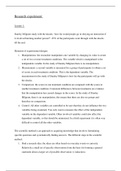Research experiment:
Lecture 1:
Stanley Milgram study with the shocks: ‘how far would people go in obeying an instruction if
it involved harming another person?’. 65% of the participants went through with the shocks
till the end.
Elements of experimental designs:
1. Manipulations: the researcher manipulates one variable by changing its value to create
a set of two or more treatment conditions. The variable which is manipulated is the
independent variable. In the study of Stanley Milgram there is no manipulation.
2. Measurement: a second variable is measured for a group of participants to obtain a set
of scores in each treatment condition. This is the dependent variable. The
measurement in the study of Stanley Milgram is how far the participants will go with
the shocks.
3. Comparison: the scores in one treatment condition are compared with the scores in
another treatment condition. Consistent differences between treatments are evidence
that the manipulation has caused changes in the scores. In the study of Stanley
Milgram, there is no manipulation, this means that there are also no groups and
therefore no comparison.
4. Control: All other variables are controlled to be sure that they do not influence the two
variables being examined. You only want to measure the effect of the independent
variable on the dependent variable. Other involved variables could also affect the
dependent variable, so this should be minimized. In a field experiment it is often very
difficult to control all the other variables.
The scientific method is an approach to acquiring knowledge that involves formulating
specific questions and systematically finding answers. The different steps in the scientific
method:
1. Find a research idea: the ideas are often based on everyday events or curiosity.
Relatively a small set of specific observations form the basis for forming a general
statement about a larger set of possible observation (= induction).
, 2. Hypothesis: identifying the factors or variables that are associated with your
observation. Variables are characteristics or conditions that change or have different
values for different individuals. Formulate a hypothesis, or a possible explanation for
your observation.
3. Define and measure the variables. In this step, it is important that you focus on the
dependent and independent variables, but also other variables that may influence the
dependent variable.
4. Identify and select participants: so, for example how many participants are needed and
what kind of participants? The minimum of participants is 30 per experimental group,
but because people do not always fit the criteria, it is important to recruit more than
thirty.
5. Select a research strategy:
a. Experimental design.
b. Quasi experimental design.
c. Non-experimental design,
d. Correlational design.
The research strategy depends on the research question. There are three types:
I. Examining individual variables instead of relationships between variables.
II. Examining relationships between variables by measuring two variables for
each participant.
III. Examining relationship between variables by comparing two groups or more.
Type of research question Strategies Classification
Description of variables Descriptive Non-experimental
Correlational
Non-experimental
Quasi-experimental
Relationship between Experimental Experimental
variables in terms of cause
and effect
Correlation: indicates a relationship between two events.
Causation: indicates that the occurrence of one event has caused the occurrence of a second
event.
,The goal of the experimental research strategy is to establish the existence of a cause-and-
effect relationship between two variables.
By manipulating the independent variable, we create different groups, and the groups receive
different treatments. The different scores of the dependent variables are caused by the
treatment, unless there are third variables/extraneous variables. Extraneous are all the
variables beyond the independent and dependent variables. Every experiment is filled with
them. The goal of a proper experimental design is to control these extraneous variables.
Extraneous variables become problematic when they become confounding variables.
Confounding variables influence the dependent variable. Something totally unrelated to the
dependent variable is not a threat. If the confounding variable varies systematically with the
independent variable, it is a threat. A variable that changes randomly with no relation to the
independent variable, is not a threat. Once a limited set of specific variables with real
potential as confounding variables is identified, it is possible to control them.
Different ways to control extraneous variables:
1. Control by randomization. When testing the effect of KitKat commercials, the
level of hunger in the two treatments of the participants will be the same, due to
randomization.
2. Holding a variable constant. A certain variable which might have an effect on the
dependent variable may not differ between the treatment groups. For example,
making sure that everybody gets food before the experiment, so no one is hungry.
For example, only using male participants of a specific age. Gender and age are
then controlled.
3. Matching: the researcher purposely makes sure that there are diverse people in
every treatment group. You make sure that every group has a hungry person and a
not hungry person.
Internal validity: is concerned with factors in the study that raise doubts or question about the
interpretation of the results. A study is said to have a good internal validity if it allows one
and only one explanation of the results.
External validity: the extent to which we can generalize the results of a research study to
people, settings, times, measures and characteristics other than those used in that study. A
, threat to external validity is any characteristic of a study that limits the ability to generalize
the results from a research study.
Sometimes increasing internal validity can reduce external validity (=e.g. The setting is
under control with internal validity, but that probably makes the results less generalizable to
other settings).
Attempts to increase external validity can also reduce internal validity. For example, with a
high external validity.
It is thus very important to balance these different types of validity.





